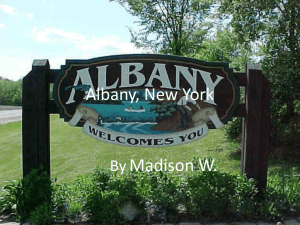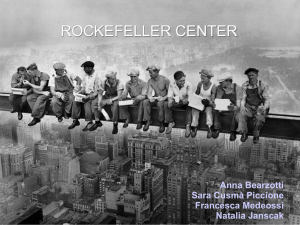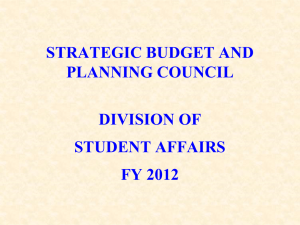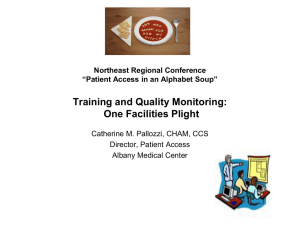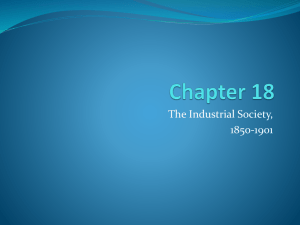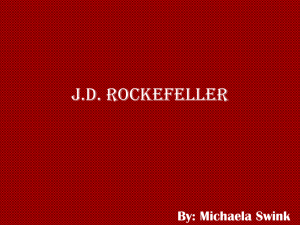Introduction to System Dynamics
advertisement
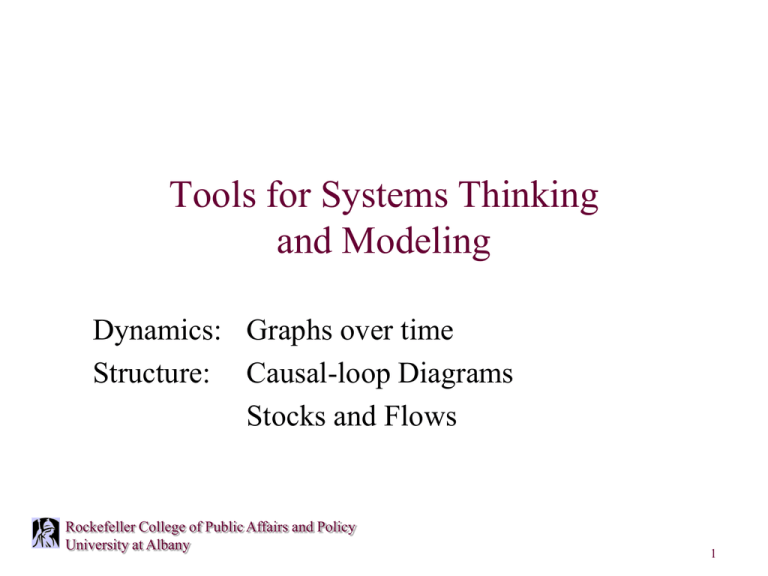
Tools for Systems Thinking and Modeling Dynamics: Graphs over time Structure: Causal-loop Diagrams Stocks and Flows Rockefeller College of Public Affairs and Policy University at Albany 1 A Systems Perspective Reactive Events and Decisions Adaptive Patterns of Behavior Generative System Structure Rockefeller College of Public Affairs and Policy University at Albany 2 “Distancing...” A systems view stands back just far enough to... • Deliberately blur discrete events into patterns of behavior • Deliberately move from a focus on individual decisions to a focus on policy structure Rockefeller College of Public Affairs and Policy University at Albany 3 The Systems Perspective Reactive Events and Decisions Adaptive Patterns of Behavior Generative System Structure Rockefeller College of Public Affairs and Policy University at Albany 4 Dynamics • Define problems in terms of graphs over time. • Graph important variables • Graph historical data • Graph anticipated dynamics • Graph preferred dynamics • Use these to focus systems thinking and modeling Rockefeller College of Public Affairs and Policy University at Albany 5 Unemployment (%) Rockefeller College of Public Affairs and Policy University at Albany 6 New York City Population, 1900-2000 Rockefeller College of Public Affairs and Policy University at Albany 7 Unemployment & Welfare in Dutchess County, NY Welfare roll Unemployment Rockefeller College of Public Affairs and Policy University at Albany 8 Per Capita Residential Energy Use (USA Today 3/23/09, citing Census Bureau and U.S. Energy Information Administration) 5000 4000 3000 2000 1000 0 1950 1960 1970 Rockefeller College of Public Affairs and Policy University at Albany 1980 1990 2000 2010 9 Strive for Insights Here’s where we went wrong... Rockefeller College of Public Affairs and Policy University at Albany 10 The Systems Perspective Reactive Events and Decisions Adaptive Patterns of Behavior Generative System Structure Rockefeller College of Public Affairs and Policy University at Albany 11 Systems Structure • • • • • • • Accumulations (populations, resources…) Causal structure: “feedback” loops Delays Perceptions (a kind of accumulation) Pressures Affects, emotions, (ir)rationalities Policies governing decisions Rockefeller College of Public Affairs and Policy University at Albany 12 Causal Loop Diagrams Crime rate • Causal mapping is a powerful tool for representing structure in complex systems. • Arrows indicate causal influence. Quality of city life Neighborhood health clinics Inmigration Rockefeller College of Public Affairs and Policy University at Albany Retail outlets Population Absentee landlords Outmigration 13 Polarities of Causal Links • Positive and negative signs show the direction of causality: + ... “direct” relation – …“inverse” relation Crime rate + – Quality of city life – + Neighborhood health clinics Inmigration Rockefeller College of Public Affairs and Policy University at Albany Retail outlets + Population Absentee landlords – Outmigration 14 Definitions of Link Polarities A adds to B, or ∆A leads to ∆B in the same direction C subtracts from D, or ∆C leads to ∆D in the opposite direction All words phrases are expressed as quantities that have a clear sense of increase or decrease. No verbs — the action is in the arrows. Rockefeller College of Public Affairs and Policy University at Albany 15 Simple test for link polarity An increase in A makes B higher than it would have been without the change. An increase in C makes D lower than it would have been without the change. Rockefeller College of Public Affairs and Policy University at Albany 16 Examples Lawyers Outmigration + Court cases – Population More lawyers mean more litigation; fewer lawyers, less litigation Emigration subtracts from population: An increase in emigration means less (a decrease means more) than we’d have without the change “Ceteris paribus”... All other influences held constant as we assign polarities. Rockefeller College of Public Affairs and Policy University at Albany 17 Exercises Reglatory delays in the planning process Citizen ownership of the outcomes Citizen participation in the planning process Anxiety Productivity Ratiation of heat away d from the earth Concentration of green house gases in atmosphere Rockefeller College of Public Affairs and Policy University at Albany Global average temperature 18 Feedback Loops A feedback loop exists when decisions change the state of the system, changing the conditions and information that influence future decisions. Action State of the system Decisions Perceptions Rockefeller College of Public Affairs and Policy University at Albany 19 The Joy of Feedback Rockefeller College of Public Affairs and Policy University at Albany 20 The Joy of Feedback Rockefeller College of Public Affairs and Policy University at Albany 21 No — it’s more like the life cycle of the famous scientist Rockefeller College of Public Affairs and Policy University at Albany 22 Examples of Feedback Loops Solvency of a Bank Deposits Withdrawals Perceived solvency of the Bank Quality of communication Trust Risk taking Rockefeller College of Public Affairs and Policy University at Albany Quality of communication between teams Quality of communication within teams Teamwork 23 Two kinds of feedback loops • Reinforcing loops • Balancing loops • Growth producing • Counteracting • Destabilizing • Goal seeking • Accelerating • Stabilizing • Positive: an even number of –’s • Negative: an odd number of –’s • Symbolized by Rockefeller College of Public Affairs and Policy University at Albany • Symbolized by 24 Examples of Reinforcing Loops Performance Births per year + + Population + + Motivation + Number of private businesses Attractiveness for business + + Expected profitability of business – Rockefeller College of Public Affairs and Policy University at Albany Tax rate Tax base – 25 Isolate and Identify Link Polarity Attractiveness for business Number of private businesses Expected profitability of business Tax base Tax Rate Rockefeller College of Public Affairs and Policy University at Albany 26 26 Isolate and Identify Link Polarity (Always trace an Increase) Attractiveness for business + Number of private businesses Expected profitability of business Tax base Tax Rate Rockefeller College of Public Affairs and Policy University at Albany 27 27 Isolate and Identify Link Polarity (Always trace an Increase) Attractiveness for business Number of private businesses + Expected profitability of business Tax base Tax Rate Rockefeller College of Public Affairs and Policy University at Albany 28 28 Isolate and Identify Link Polarity (Always trace an Increase) Attractiveness for business Number of private businesses Expected profitability of business Tax base Tax Rate Rockefeller College of Public Affairs and Policy University at Albany – 29 29 Isolate and Identify Link Polarity (Always trace an Increase) Attractiveness for business Number of private businesses Expected profitability of business – Rockefeller College of Public Affairs and Policy University at Albany Tax base Tax Rate 30 30 Isolate and Identify Link Polarity (Always trace an Increase) Attractiveness for business Number of private businesses + Expected profitability of business Tax base Tax Rate Rockefeller College of Public Affairs and Policy University at Albany 31 31 Completed Loop (Now tell the story) Attractiveness for business + Number of private businesses + + (R) Expected profitability of business – Rockefeller College of Public Affairs and Policy University at Albany Tax base Tax Rate – 32 32 Typical Reinforcing Loop Behaviors 20,000 15,000 Population and Births Loop 10,000 5,000 10,000 0 0 25 50 75 100 9,000 8,000 Businesses and Taxes Loop 7,000 6,000 Rockefeller College of Public Affairs and Policy 0 University at Albany 25 50 75 100 33 World Population (billions) 8 6 4 2 0 1500 1600 1700 Rockefeller College of Public Affairs and Policy University at Albany 1800 1900 2000 34 Self-reinforcing processes in world population growth Rockefeller College of Public Affairs and Policy University at Albany 35 Reinforcing Feedback in the Newspaper Rockefeller College of Public Affairs and Policy University at Albany 36 Reinforcing Feedback in the Newspaper Rockefeller College of Public Affairs and Policy University at Albany 37 Reinforcing Feedback in the Newspaper Garfield’s (R) Jon’s happiness suspicion Rockefeller College of Public Affairs and Policy University at Albany 38 Examples of Balancing or Counteracting Loops + Water in glass Desired amount of water in glass + Pouring rate + Population – - Fraction filled – Gypsie moth net growth – Wasps Rockefeller College of Public Affairs and Policy University at Albany Outmigration + Gypsie moths + + Wasp net growth 39 Typical Counteracting Loop Behaviors 20 Filling a Glass 15 Predator-prey interactions 10 5 0 010,000 10 20 30 40 7,500 •0 5,000 •15 •22.5 •30 Population and emigration 2,500 0 •7.5 0 25 50 Rockefeller College of Public Affairs and Policy University at Albany 75 100 40 Tips for Determining Link and Loop Polarities • For each link, determine the effect of an increase in the variable at the tail of the arrow: • If the variable at the head increases, assign a plus. • If the variable at the head decreases, assign a minus. • For each loop, count the number of negative signs: • An even number of negative links is a reinforcing (R) loop. • An odd number of negative links is a balancing (B) loop. • Most important: For each loop, tell a self-reinforcing or balancing/counteracting story, and check that the story matches the loop polarity. Rockefeller College of Public Affairs and Policy University at Albany 41 More Serious Example from the Newspaper: Recall the graph of per capita energy use 5000 4000 3000 2000 1000 0 1950 1960 1970 1980 1990 2000 2010 Rockefeller College of Public Affairs and Policy University at Albany 42 Presentation Dynamics Clarity of presentation Audience understanding Rockefeller College of Public Affairs and Policy University at Albany Clarifying questions 43 Presentation Dynamics - Which loop dominates? Rockefeller College of Public Affairs and Policy University at Albany 44 Stocks and Flows Stocks are accumulations. • Stocks are increased by inflows and decreased by outflows. • When a link means “add” or “subtract” we have a stock-andflow structure. • Example: Inventory Rockefeller College of Public Affairs and Policy University at Albany 45 Stock and Flow Diagramming Conventions Rockefeller College of Public Affairs and Policy University at Albany 46 A Stock and Flow Example Explicit stocks and flows: The corresponding causal-loop diagram: Rockefeller College of Public Affairs and Policy University at Albany 47 Human Activity, CO2, and Global Temperature Thought experiment: Capital stock CO2 annual production Atmospheric CO2 Uptake of atmospheric CO2 Economic activity capital investment incoming solar heat energy Rockefeller College of Public Affairs and Policy University at Albany Global heat energy outgoing global heat energy 48 Structure and Dynamics of Terrorist Cells Peripheral support (R) Suppression activities (R) (R) (R) Zeal Funding New (R) Terrorist recruits group (R) Martyrs to the cause Rockefeller College of Public Affairs and Policy University at Albany Terrorist actions (B) (B) Losses (R) 49 Balancing Loops Balancing or in Tobacco Loops Counteracting Prevalence Researchers awarness of tobacco health risk + Smokers + Public awareness of tobacco health risk + Three views People quitting smoking Rockefeller College of Public Affairs and Policy University at Albany 50 Tax revenues from smokers Balancing Loops Balancing or in Tobacco Loops Counteracting Prevalence + + Govt funding of tobacco control Researchers awarness of tobacco health risk Funding for tobacco health research + + Smokers Public awareness of tobacco health risk - People quitting smoking Rockefeller College of Public Affairs and Policy University at Albany + Funding for tobacco control programs + + + Three views +Gov. income + Tobacco control programs + + Health insurers coverage of tobacco quitting costs 51 Loops and Constituencies Pro-tobacco contituencies + + + Anti-tobacco constituencies Govt awareness of tobacco health risk + + + + + + Researchers awarness of tobacco health risk Health care costs + Funding for tobacco health research + + + + Smokers Tobacco revenues + + Trend in tobacco company revenues + Tobacco growers + Tobacco control programs + People starting smoking + People quitting + smoking - + + Public awareness of tobacco health risk - + Funding for tobacco control programs Smoking as a social norm - + + Tobacco marketing activities - + + Tobacco products availability Rockefeller College of Public Affairs and Policy University at Albany Pressure on tobacco companies to reduce marketing activities + 52 There are a lot … Perceived importance of other health programs <Anti-tobacco litigation> - + + +Tobacco taxes Govt awareness of tobacco health risk + + Pro-tobacco contituencies ++ + + + Trend in tobacco company revenues + Tobacco production capacity + Smoking as a social norm + Public awareness of tobacco health risk + + + People starting smoking + People quitting + smoking + - + Funding for tobacco control programs + + - + Tobacco control programs + + Health insurers coverage of tobacco quitting costs + Tobacco marketing activities - +Gov. income + Funding for tobacco health research + + Smokers + Tax revenues from smokers + Govt funding of tobacco control Researchers awarness of tobacco health risk + + Tobacco revenues + Anti-tobacco constituencies + + Health care costs Anti-tobacco litigation Anti-tobacco legislation <Perceived importance of other health programs> - Govt willingness to + act against tobacco Tobacco products + availability xxx Rockefeller College of Public Affairs and Policy University at Albany Pressure on tobacco companies to reduce marketing activities 53 Policy Resistance of Complex Systems Rockefeller College of Public Affairs and Policy University at Albany 54 Policy Resistance of Complex Systems Rockefeller College of Public Affairs and Policy University at Albany 55 Policy Resistance of Complex Systems Rockefeller College of Public Affairs and Policy University at Albany 56 Policy Resistance in Complex Systems Rockefeller College of Public Affairs and Policy University at Albany 57
